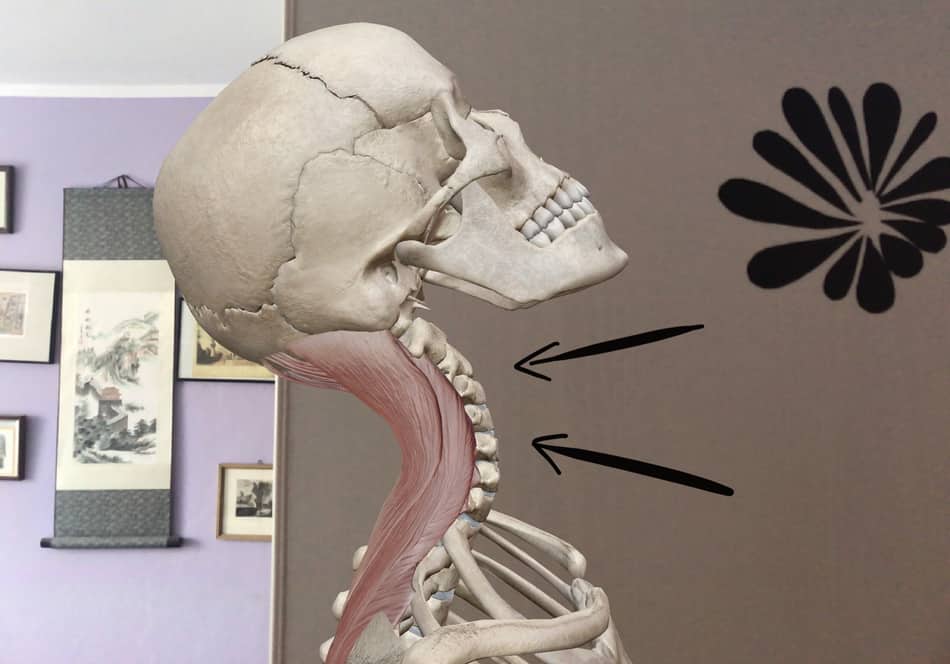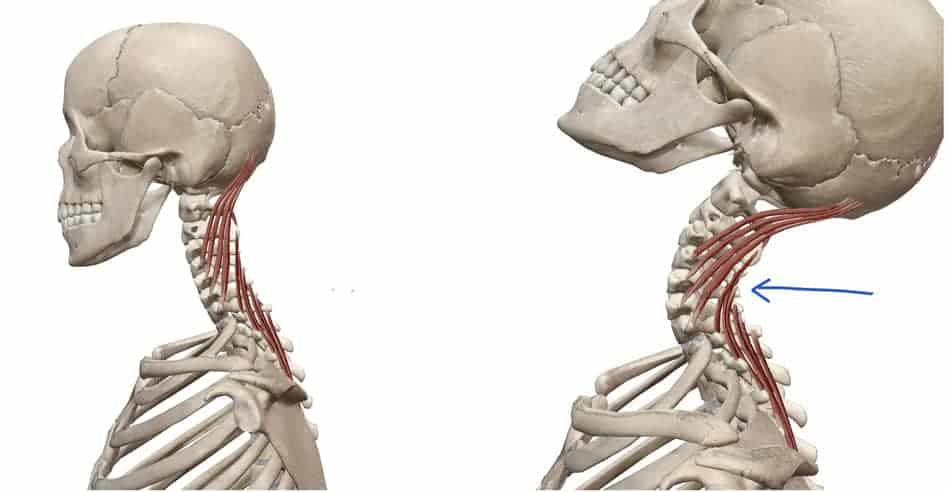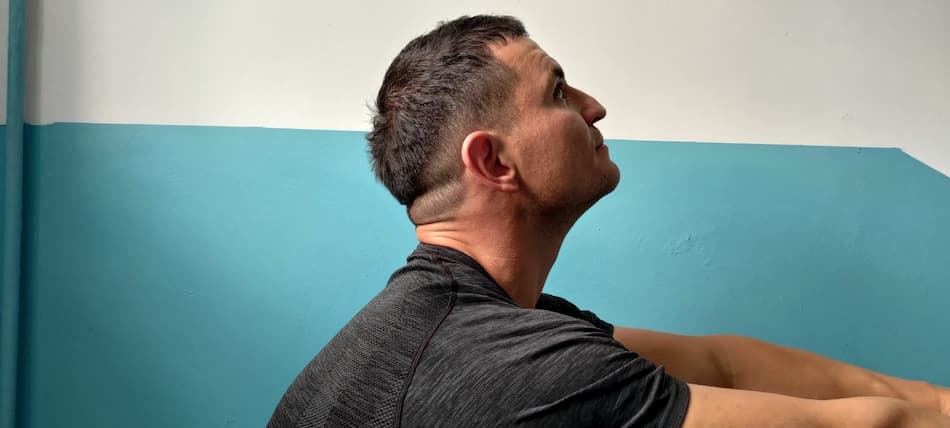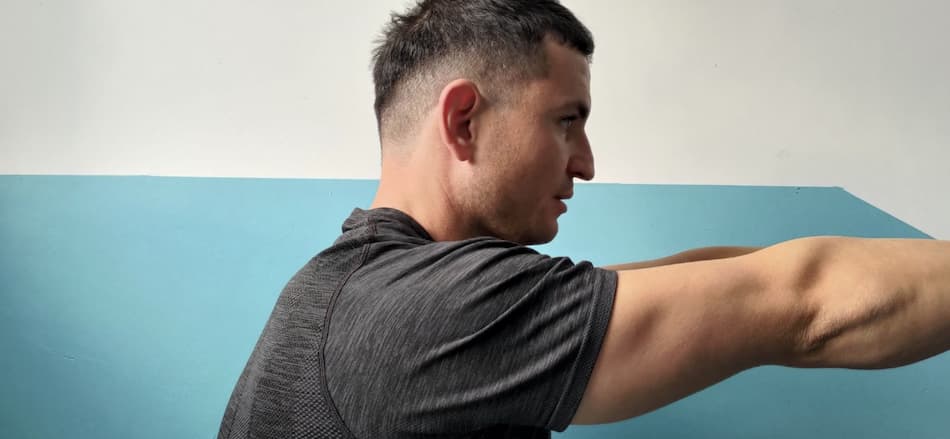Kettlebell swings can cause neck and shoulder pain when performed incorrectly.
That usually happens during the eccentric phase, when the kettlebell travels down towards the hips, and the necks stay in the extension.
This extension during the eccentric phase can create a kink in the neck. This kink, over time, with enough reps under the load, may start to cause discomfort.

Here’s the good news. You can fix that easily.
Kettlebell swings and neck pain
Swing is a dynamic, hip hinge movement. This means that from the moment you pick up the weight, all the way to the very end, you are in constant motion.
And this is good.
You thrust from your hips over and over again which creates this therapeutic compression on your lower back.
Muscles contract and relax.
It’s like a pendulum. You are using energy back and forth. Almost like a rollercoaster ride.
You use power to swing the kettlebell up, and at the same time, you constantly hold and control the weight as you lower it down.
As much as this constant tension comes with a lot of benefits, it is important to keep our bodies in line so we don’t get into trouble.
The Problem

The main reason for neck pain after KB swings is the compression of the nerves in the cervical spine during the eccentric phase of the swing.
Sometimes, especially after a high volume of reps, people “forget” to keep their heads in the neutral spine position.
In the picture above you can see what I’m talking about.
Here is an example from real life.

And here’s the thing.
Our nerves are designed to withstand tension, slide in their “containers”, and be compressible. That’s normal.
That’s why you can flex and extend your neck without any discomfort.
The problem start’s when you add weight. Under the heavy load, you simply put too much tension, compression, and stress on those nerves.
In the end, you receive the pain signal.
How to do kettlebell swings without neck pain
To get rid of this problem, first, you must always stay in the neutral spine position. This means letting your neck follow you as you swing.
See the picture below.

Start from the proper position
Kind of like hiking in football but keep your back straight.
Your feet should be planted into the ground, without any movement. This means no standing up and down on your toes.
The movement isn’t about going deep down as you would in the squat. It’s more about a hip extension.
When you get to the end range (when the kettlebell is between your legs), your back should be almost parallel to the ground.
Start the swing
To start the swing, you powerfully thrust your hips with a strong glute contraction.
Holding the kettlebell with both arms you swing it up until you reach your shoulder level.
Keep your head straight
Your head should be looking forward.
On your way down, you shift the weight to the front, slightly bending your knees, with your head traveling until you start seeing your feet.
In the bottom position, the kettlebell should be above the knees, as close to your midline as possible. Never keep the kettlebell below the knees.
Maintain straight back
At the bottom, you shouldn’t be any lumbar flexion. This means all the bending comes from the hip extension.
At the top, there shouldn’t be any hyperextension. You squeeze your glutes and keep your core sucked in.
Keep your arms relaxed
The arms shouldn’t be forced to swing the kettlebell. The power comes from your hips. Arms just hold and control the weight.
Here in this video, you can see the perfect kettlebell swing form.
Is there anything else that can cause neck problems?
It’s all about self-awareness.
Sometimes you may find that your form is decent, but you still experience some level of discomfort. That happens too.
So here you must think outside of the box about what can be the problem.
Other Exercise
Remember that there may be something else in your training routine that aggregates the neck, and swings just make it worse.
- It’s like pouring gasoline into a fire.
- Start by addressing the correct form.
- Also, do a little body scan of what other exercises you do that can keep your neck in the compromised position.
So you don’t just keep the swings in check, but your entire program, and see if there is something that you missed.
Always focus on the correct form.
Work
One of the common reasons why people have neck pain can also be caused by the work they do.
If you are tired after work, and then you do heavy swings, it’s more likely to experience this unnecessary tension.
In the article written by B. Cagnie from Ghent University, Belgium, they assessed work-related neck disorders, especially among heavy computer users.
According to Dr. Cagnie, there is a significant correlation between mental tiredness, shortage of personnel, and neck pain from holding the neck in a forward bent posture after a long period of time.
And I can only imagine what happens if someone is going to do a heavy set of KB swings after a long and stressful day at work.
What to do?
- I would recommend adding some mobility drills to the warm-up. Spend extra time stretching and recognizing how your body feels.
- You can also try to foam roll the upper and lower back. This may relieve some muscle tension and helps with the problem.
And if you feel something is not right, change the exercise.
- Also, consider some ergonomic workplace settings that will stop the cause of this issue.
- This means the integration of sit-stand option desks.
The idea behind those sit-stand desks is to allow for a comfortable change in the work position.
There is a popular phrase that sitting is ‘second smoking’. But standing all day at work isn’t much better either.
So the slogan should be “sedentary is the second smoking”.
Sleep
Another big factor, sometimes neglected, is the sleep position, and sleeping patterns.
Sleep is a complex physiological process that is essential for optimum quality of life.
And it’s not a secret that sleeping patterns and interruptions can lead to a number of problems.
For example.
- Cognitive abilities
- Emotions
- Muscle tension
Stephanie M. Greer, Ph.D., a researcher from the University of California, Berkeley, says “there is a correlation between lack of sleep that leads to the excess subcortical response in the amygdala and obesity.”
In her recent study, she concluded that lack of proper sleep can really mess up the system.
“The position we sleep in can dictate how much muscle tension we can get,” says Dr. Greer.
Dr. Greer suggests using an appropriate pillow as a simple solution.
Another recent article written by Alessandra DI Cagno, Ph.D., shows that using the cervical pillow is an effective way to relieve neck pain and promote deeper stages during sleep.
How often should you do kettlebell swings?
Once you checked all the boxes then it’s time to train.
However, if you notice that your neck seems to bother you after some number of reps, try to be flexible with your training program.
Just because someone is doing 200 swings a day, and it works wonders for them, it doesn’t mean you should be doing the same approach.
Especially if you feel pain.
The same with the number of training sessions.
Don’t feel obligated (or worse, guilty) if you can’t exercise every day. Some people will be fine. But if you have some symptoms, then reduce them to the point where you can be pain-free.
Start slowly. Even once a week.
As you progress, and you get familiar with the correct technique, you can move up the ladder. Better be safe than sorry.
Conclusion
- Always listen to your body, and don’t pay too much attention to what other people do.
- If you feel lost and you just don’t know what exercise you could do, I would recommend hiring a reputable trainer.
- Sometimes people want to cut the cost, they put on some YouTube videos, and “copy” what others do. This is ok if you understand the biomechanics.
- But if you don’t spend some time with a trainer that can really help you get fit and stay pain-free at the same time.
